Hiking trips will take a toll on your feet and legs because you will walk long distances and often on uneven if not downright rocky terrain. Therefore, you should wear good hiking footwear which will protect your feet from injuries and enhance your performance. Because hiking footwear varies greatly in weight, design, support and cushioning, it can be hard to choose a pair of hiking boots or shoes, not least for those who are new to hiking.
To minimize the confusion we made this hiking footwear guide which explains the differences between different types of hiking footwear and points out what is each type of hiking footwear suitable for. We also dive into the anatomy of hiking boot and explain how different materials will affect the performance of footwear. If you are looking for a pair of new hiking boots or shoes, check out our list of the best hiking boot brands. These brands offer top-notch boots and shoes within each category of hiking footwear.
Table of Contents:
Types of Hiking Footwear
We can divide hiking footwear into three groups; hiking shoes, lightweight hiking boots and backpacking/mountaineering boots. Below is a short description of each group.
Types of Hiking Footwear:
Hiking Shoes
Best for: Hiking on technically undemanding terrain with light loads
Common characteristics: Low-cut (around the ankle), synthetic upper, EVA midsole
Typical weight: less than 900 grams / 2 lbs. (a pair)
Hiking shoes or trekking shoes are low-cut (around the ankle) and thus provide very little ankle support. Therefore, they are not suitable for hiking on rocky terrain or for multiday trips where you might be carrying a heavy backpack. Hiking shoes are normally lighter than other hiking footwear and have softer and more flexible soles. Because of that, they provide good comfort and performance on “easy” trails (dirt tracks, muddy/grassy trails etc.).
Lightweight Hiking Boots
Best for: Hiking on technically undemanding terrain with light to medium loads
Common characteristics: Mid-cut or high-cut (e.g. above the ankle), synthetic upper, EVA midsole
Typical weight: around 1000 grams / 2 lbs. 3 oz. (a pair)
Lightweight hiking boots (mid-cut or high-cut) provide better ankle support then hiking shoes but not as good as mountaineering/backpacking boots. They are also lighter and less durable then mountaineering and backpacking boots due to lightweight materials they utilize. Furthermore, they have softer and more flexible soles – often as flexible as hiking shoes. Due to the low weight, flexible soles and decent ankle support they are perfect for hiking on established trails (dirt tracks and muddy/grassy trails) with light to medium loads (backpacks weighing less than 10 kg). They are, however, not suitable for very rocky and uneven terrain because they don’t offer sufficient support, stability or durability.
Mountaineering and Backpacking Boots
Best for: Hiking on technically challenging terrain (also via ferrata); hiking with a heavy backpack; hiking with crampons (C1); hiking with snowshoes
Common characteristics: Mid-cut or high-cut (e.g. above the ankle), leather upper, PU midsole
Typical weight: more than 1000 grams / 2 lbs. 3 oz. (a pair)
Mountaineering and backpacking boots (mid-cut or high-cut) differ from trekking shoes and lightweight hiking boots by being more robust and stiff to provide good stability and support on rocky and uneven terrain – as well as when you are carrying heavy loads, regardless of terrain. The more rigid soles will provide better comfort exactly because they don’t flex around every root, stone etc. on the trail, even when you are carrying a heavy backpack. Furthermore, such hiking boots can also be used with snowshoes or C1 crampons (strap-on bindings). The downside of mountaineering and backpacking boots is that they are less breathable and heavier (due to the more robust materials) than other hiking footwear, and thus they are not the best option for day hikes, except if the terrain is very demanding. They are in most cases also more expensive than both lightweight hiking boots and trekking shoes.
Anatomy of a Hiking Boot
In the following we will describe the individual components of a hiking boot/shoe and how these components differ between the three different types of hiking footwear outlined above.
Hiking Boot Componenets:
Upper
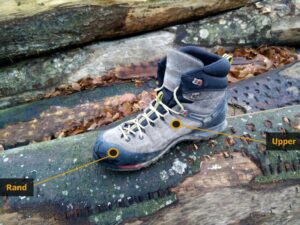
Hiking Footwear Guide – Image shows Salewa Mountain Trainer boot which has upper made of nubuck leather
The upper is the upper part of a hiking boot/shoe and provides protection against the surroundings. The upper has to be breathable, durable and water-resistant to provide good comfort and performance.
Uppers are made of leather (full-grain leather, split-grain leather, nubuck leather etc.), synthetic materials (Cordura, nylon mesh, polyester etc.) or a combination of leather and synthetic materials (leather is often paired with nylon mesh). Some hiking boots also have an all-around polyurethane rand for better abrasion-resistance. Each upper material has its pros and cons.
Full-grain Leather:
Uppers made of full-grain leather are typically used for robust mountaineering and backpacking boots because they are very durable, abrasion-resistant and fairly rigid for good ankle support. Very little stitching is required to produce full-grain leather uppers which increases the durability. Full-grain leather is also water-resistant. However, full-grain leather is less breathable, heavier and more expensive that other upper materials.
- Pros: Durable, abrasion-resistant, water-resistant, rigid (good ankle support)
- Cons: Breathability, heavy, expensive
Split-grain Leather:
Split-grain leather refers to animal hides that have the top-grain removed which makes the leather thinner than full-grain leather. Split-grain leather is normally combined with nylon or polyester mesh and thus hiking footwear with such uppers is light and breathable. However, combining textile and leather requires a lot of stitching which decreases the durability. Split-grain leather + nylon/polyester mesh uppers are normally used for hiking shoes and lightweight hiking boots.
- Pros: Less expensive than full-grain leather, breathable, lightweight (when combined with textile)
- Cons: Less durable and abrasion-resistant than full-grain leather, stitching further decreases the durability (when combined with textile)
Nubuck Leather:
Nubuck leather is top-grain leather that is sanded or buffed to have a suede-like surface. Nubuck leather is less expensive, lighter, softer and more breathable than full-grain leather but on the other hand it is also less abrasion- and water-resistant. Uppers made of Nubuck leather are used for lighter mountaineering/backpacking boots as well as for rugged lightweight hiking boots and robust trekking shoes.
- Pros: More breathable, less expensive and lighter than full-grain leather
- Cons: Less abrasion-resistant than full-grain leather
Synthetic Materials:
Synthetic uppers normally combine porous nylon mesh with stiffer synthetic materials for increased durability and support. They are lighter and provide better breathability than uppers made of other materials. Furthermore, they also dry faster and are less expensive. However, synthetic uppers are significantly less abrasion-resistant and durable than uppers made of leather. Therefore, they are normally used for trekking shoes and lightweight hiking boots.
- Pros: Superb breathability, quick-drying, inexpensive, super lightweight
- Cons: Abrasion-resistance, durability
Lining
The lining is the material on the inside of a hiking boot/shoe and because it is in direct contact with your sock-clad foot, it is important that it is breathable and moisture-wicking. The lining has to transport moisture from the sock to the outside to reduce the conductive heat loss and friction. Wet feet get cold very fast and can often get blisters due to the increased friction between the skin and the sock. The upper and lining are usually joined with an adhesive, but it is very important that the adhesive does not reduce the breathability or transportation of moisture. As the lining is constantly exposed to abrasion and friction it is also important that it is made of a pilling-resistant material. The most common material for lining is nylon. The lining also provides insulation and water-resistance.
Waterproof Lining:
Waterproof boots utilize waterproof/breathable lining such as Gore-Tex or eVent. It’s important to note that a waterproof lining reduces the breathability and transportation of moisture to some extent. There is always a trade-off between water-resistance and breathability when it comes to waterproof fabrics. The more water-resistant the fabric is, the less breathable it will be. However, by utilizing modern technologies manufacturers can nowadays produce fairly breathable fabrics that offer good water-resistance. It is also important to know that “waterproof” boots are never completely waterproof. If they would be, they wouldn’t provide any breathability and thus your feet would soak in your sweat. “Waterproof” boots normally keep your feet dry on wet terrain and in rainy weather but you shouldn’t expect that they won’t leak if you step into a stream or a puddle. For general information about waterproof/breathable fabrics check our article Comparison of Shell Materials.
Insulated Lining:
Boots that are designed for winter activities normally feature an insulated lining such as Gore-Tex Insulated Comfort, Primaloft Gold and Thinsulate. Insulated lining includes a layer of polyester fleece or synthetic fill for thermal insulation. For general information about insulation fabrics check our article Comparison of Mid-layer Materials.
Tongue and Lacing
The tongue and lacing of a hiking boot allow you to adjust the fit of the boot. The tongue is normally made of highly breathable materials such as nylon mesh (sometimes even on boots that feature leather uppers) and padded to provide good comfort. Like the lining, the tongue has to transport moisture from the sock to the outside where it can evaporate. On backpacking and mountaineering boots the tongue is almost always connected to the upper along its sides so that it prevents dirt from entering into the boot.
The quality of lacing is of the utmost importance as it keeps the boot on your foot and severe malfunctions can thus make the footwear useless. Therefore, it’s important that your hiking footwear is equipped with durable eyelets/loops that can withstand regular impacts. Furthermore, the shoelaces should also provide good durability – some robust hiking boots feature shoelaces with Kevlar fibers for increased strength and durability.
Insole
The insole (also referred to as the footbed) is the part of a boot/shoe that is directly under the foot. The insole has to be breathable and moisture-wicking so that it can transport moisture away from the sock. Insoles normally also offer some stretch as this reduces blistering on the plantar surface of the foot. Some manufacturers use antimicrobial insoles for prolonged freshness and odor-control. Insoles are usually removable so that they can be air-dried faster or replaced after time and use. In cold conditions insulated insoles (normally purchased separately) can be used for better thermal efficiency.
Midsole
The midsole is a very important part of any kind of footwear as it is responsible for cushioning, support, rigidity and stability. Midsoles on hiking footwear are made of either EVA (ethylene vinyl acetate) or PU (polyurethane). Both materials are foams and thus they provide cushioning as the air get’s squeezed out when pressure is applied to the material – and sucked back in once pressure is removed. EVA and PU differ greatly in characteristics, nonetheless.
EVA Midsoles:
EVA midsoles are usually lighter and more flexible than the PU midsoles. They are also significantly less expensive. However, EVA has one big downside; in long-term it loses its properties – meaning that the cushioning becomes less and less efficient. Some manufacturers mitigate this problem by adding different polyurethane “structures” to EVA midsoles such as cylinder-like inserts. EVA midsoles are usually used for hiking shoes and lightweight hiking boots; they are very rarely used for heavier hiking footwear because they are too flexible.
- Pros: Inexpensive, flexible (which is good for running shoes, trekking shoes etc.)
- Cons: Short term durability
PU Midsoles:
PU midsoles, on the other hand, provide much better durability as they lose cushioning a lot slower than EVA midsoles. However, they are also more expensive as well as relatively heavy and rigid. Nevertheless, PU can be adjusted to offer properties (flexibility, lighter weight) similar to EVA without sacrificing its durability, and thus PU midsoles are not only used for mountaineering/backpacking boots but also for premium trekking shoes and high-class lightweight hiking boots.
- Pros: Durability, can be very rigid (which is good for mountaineering and backpacking boots)
- Cons: Expensive
Outsole
The outsole is the part of a hiking boot that touches the ground and is thus responsible for traction. Hiking footwear usually has outsoles made of a fairly soft rubber as such outsoles provide good durability and traction on various terrains. Traction is additionally increased with lugs; the deeper and thicker the lugs, the better the traction, generally speaking. Widely spaced lugs are recommended for wet conditions (muddy trails) as they prevent mud from gathering in between them. Mountaineering and backpacking boots normally have outsoles with fairly deep lugs while the outsoles of lightweight hiking boots and hiking shoes feature shallower lugs. It’s important to note that lugs increase traction only on soft surfaces (gravel, grass, sand etc.) while on rocky terrain it is the rubber material of the outsoles rather than the lugs, which provide traction in the form of friction between the rubber and the surface.
Does the weight of hiking footwear matter?
Generally speaking, heavy footwear increases aerobic demand (heart rate, breathing and calorie consumption) and thus slows you down. In a 1980 experiment experts observed that for each 100 grams added to the shoe, the aerobic demand of running increased for 1% in average. However, it’s important to note that the level of cushioning also affects the aerobic demand; if there is too little cushioning (which would make the footwear lighter) the aerobic demand will increase as the muscles have to absorb higher landing shock. Therefore, we can conclude that weight definitely does matter, but that hiking footwear shouldn’t be light on the expense of cushioning. The midsole which provides cushioning is usually one of the heaviest parts of a hiking boot/shoe.
We’d love to hear your thought on hiking footwear. Write them in the comments below.
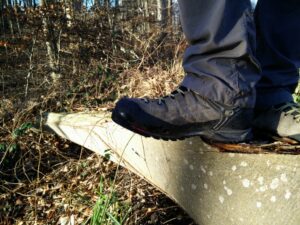
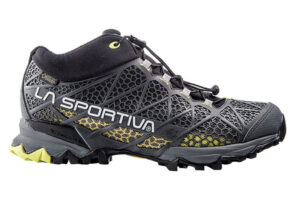
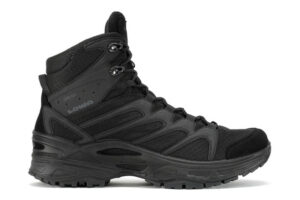
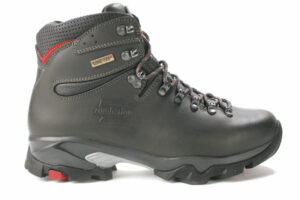
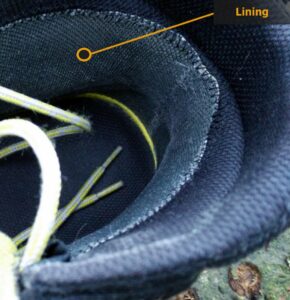

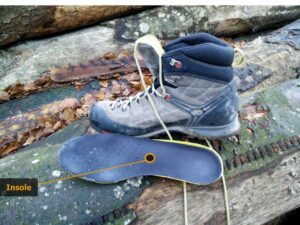
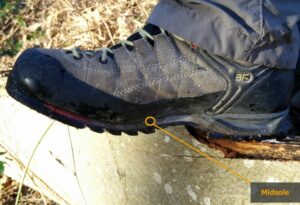
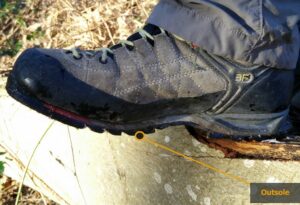
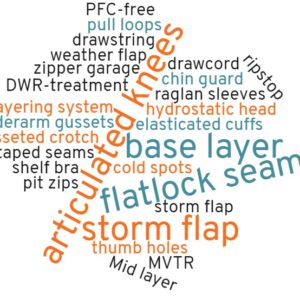
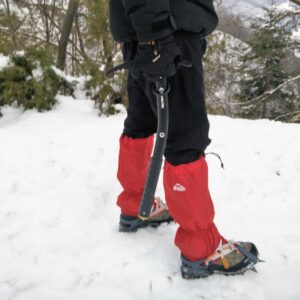













Great article! What about nubuck leather vs suede boots?
Hi Lisa! I’m glad to hear you liked the article. Nubuck and suede leather are quite similar. They’re both softer than full-grain leather. However, nubuck leather is stronger and more durable than suede leather. It’s made from the outer part of the hide while suede leather is made of softer underside of the hide.